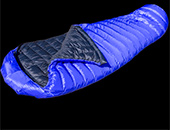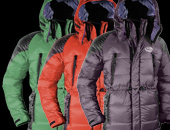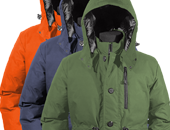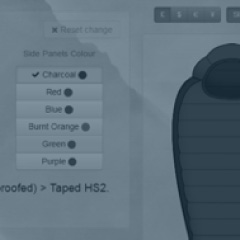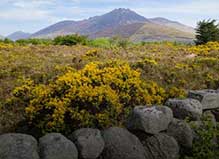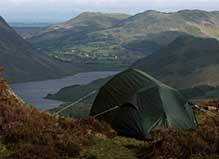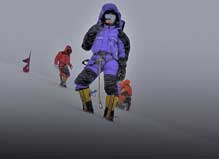Temperature Ratings
It is theoretically possible to give estimates for the insulation needed at different temperatures. At 0°C you might need 5cm of insulation, at -20°C 7cm, and so on. Or the figures might be quoted in units of thermal insulation, roughly 10 Togs (6.5 Clos) for 0°C. But quoted baldly like this the figures have no meaning. They have first to relate to what you are doing, your activity level, and even then they are for such 'idealised' conditions, ignoring wind, humidity, personal physiology and many other important factors, that they bear little relation to the real world. Each element of reality which is added to the equation multiplies the complexity of the answer, until it becomes apparent that temperature ratings are very approximate guides at best.
Like many manufacturers of insulated gear we would prefer not to give blanket ratings for our products. It would be far more accurate to talk to every customer about their particular needs. That is impractical, even for a small company like PHD, and yet customers still want some sort of guidelines. So there is little choice except to join the process and quote ratings. What follows is a brief explanation of how we go about it and of what value you can place on the results.
Sleeping Bags
Sleeping bags are the easiest. Even here ratings are necessarily hedged about with all sorts of conditions (often unstated), but they are not complete nonsense.
You have a fixed activity (hopefully you're sleeping) and you're probably in shelter, even if it's just a bivvy sac. That cuts out two of the major factors which bedevil ratings, activity levels and the wind. But it still leaves a long list of things, starting with your personal metabolism and going on to food intake, clothing, ground insulation, humidity, altitude, fitness, etc. The combination of some of these can seriously alter any figures.
To confuse the picture even further, there are certain psychological factors which often come into play. Person A feels the cold to exactly the same degree physically as person B: but A sees himself as the hardy type and puts up happily with a skin temperature which B finds unacceptable. Similar situations can arise from experience also, if A is a very practised outdoor person and is not phased by the familiar sensation of cold, while newcomer B finds it unpleasant and a bit scary.
So what to do? How can we find a way to quote meaningful ratings? Some people try to solve it by being more precise and quoting two (or more) temperature figures, 'comfort', 'extreme', etc. Others go broader and vaguer and use the 'season' rating system. But precise or vague, no system can cover for all the possible variants mentioned above.
So at PHD, knowing we can't eliminate the uncertainties, we have tried to keep it simple. What we quote for each of our bags is: a single minimum temperature (we call it a Typical Operating Temperature or TOT for short) at which you should be able to get a night's sleep under normal circumstances.
By 'normal' we mean:
- you're in shelter
- you have eaten normally
- you have sufficient ground insulation
- your bag is dry
- you're not a 'cold sleeper'
- you're wearing clothing appropriate to the conditions: below 0°C (32°F) we would expect anyone to wear at least thin thermal underwear; below -25°C (-13°) at least thick thermals.
And while we're describing what's normal, we should add that if you're an experienced 'hardy' type, you can probably take the bags below their quoted temperatures by about 5°C (9°F).
This seems like a lot of words to finish up with one fairly shaky statistic. Please take it for what it's worth, a starting point which becomes much more valuable when fleshed out by your own experience, or by experienced advice from others. If you're still in doubt about your choice, contact us and we'll try to help.
Clothing
The difficulty of establishing meaningful temperature ratings for clothing is much greater than for sleeping bags. So much so that most manufacturers sensibly don't attempt it.
Then why do we quote temperatures in our Clothing Comparison Guide? Would it not be less misleading to omit them altogether? Our feeling is that as long as we make it clear what kind of indicator you are looking at, then there is some value in a broad classification to simplify choice. This is how we go about it.
Besides actual ambient temperature there are two factors above all which affect our insulation requirements: our activity level and the wind.
Wind
Wind we have mentioned elsewhere under 'Windchill'. Most of PHD clothing has a 100% windblock outer and even our ultralight fabrics cut wind penetration effectively to zero (the only exception is our fleece). These fabrics reduce this factor to manageable proportions, although you will still need to take great care with exposed areas such as face and hands. And of course very high wind speeds will always intensify the effect of low temperatures to a point where it becomes more a question of seeking shelter than of clothing ratings.
Activity Level
It is the other major variable, activity level, which we are focusing on here. As everyone knows, activity has a dramatic effect on our metabolic rate, capable of raising it by 500% and more. Higher metabolic rate means higher internal heat production. You run, you get hot, and this applies in the Arctic too.
In clothing terms this means that the down jacket which kept you comfortable sitting down at -20°C would fry you if you started walking uphill. Or to put it the other way the lightweight insulation, which was well warm enough as you hauled your sledge at -30°C, could not prevent you shivering almost as soon as you stopped, with worse to follow.
This well-known phenomenon is traditionally dealt with by wearing several different layers of clothing which can be removed or added. But in extremely cold conditions it can be a major chore to keep altering one's clothing, and it is often more practical to have a major part of one's insulation in one layer, either something that is worn all the time like a down suit on Everest or a simple rest-stop down jacket or an overgarment like the Delta Belay jacket which can be whipped on anywhere anytime. It is therefore useful to have some assessment of what to expect from these main insulating garments.
We can't give you a comprehensive figure (or even set of figures). So as with sleeping bags we have tried to keep it simple and have given you an indicator instead, a single figure for the Typical Operating Temperature (TOT).
For clothing the TOT figure means that the item is suitable for people heading into situations where these are the minimum temperatures likely to be encountered, for use from short static periods up to medium/low activity.
It is almost irresistible to go on qualifying this statement:
- The gear would be far too warm for its quoted TOT in periods of sustained high effort e.g. sledge-hauling (at altitude effort is great, but movement tends to be slow)
- It would be OK, but chilly to bivouac in it at these temperatures
- The figures assume you can keep the insulation dry
- High altitude and extreme weather introduce new sets of rules
- Etc. etc. etc.
But allowing for these additional factors in the effort to get it exactly right is literally a never-ending process, and one can quickly get lost in a spiral of statistics, which are irrelevant in approaching an ordinary trip and inadequate for a serious one. For a big venture you will have all sorts of judgements to make and your insulating garments will be just part of your whole clothing and gear assembly.
We realise the rough and ready nature of the TOT for clothing. It is based as much on experience as on figures, but as a stand-alone indicator it is still only half-way useful: there are simply too many variables to take it further. Its chief value is to give a broad picture of what you're looking at and to allow ready comparisons between different PHD items.
Conclusion
It was not the intention if the tone of this section on ratings appears to be negative. We certainly believe in informed choice and in buying the best gear (please). But it is just an attempt to warn against the too literal acceptance of any temperature ratings, not just PHD's. They are fine, as has hopefully been explained above, as rough signposts and they are certainly useful to narrow down a general choice.
But the more critical the decision, the more weight you should give to human knowledge and judgement, which can bring into play the relevant variables. As always experience, your own and other people's, provides the best and subtlest guide.



